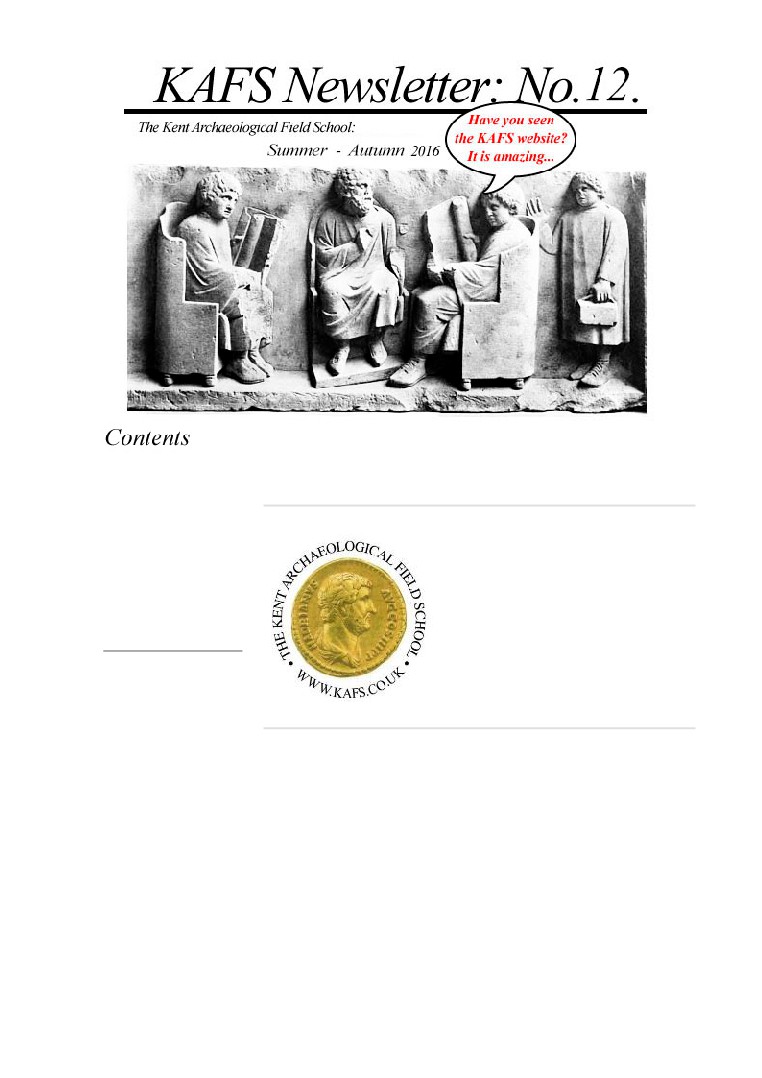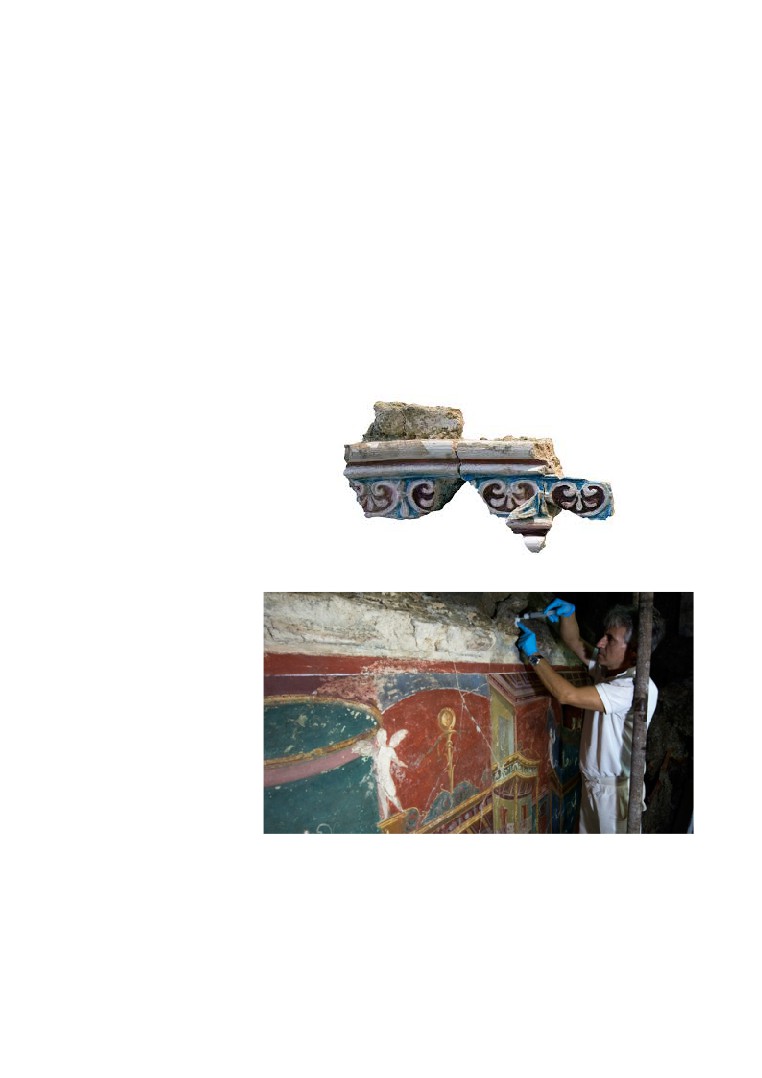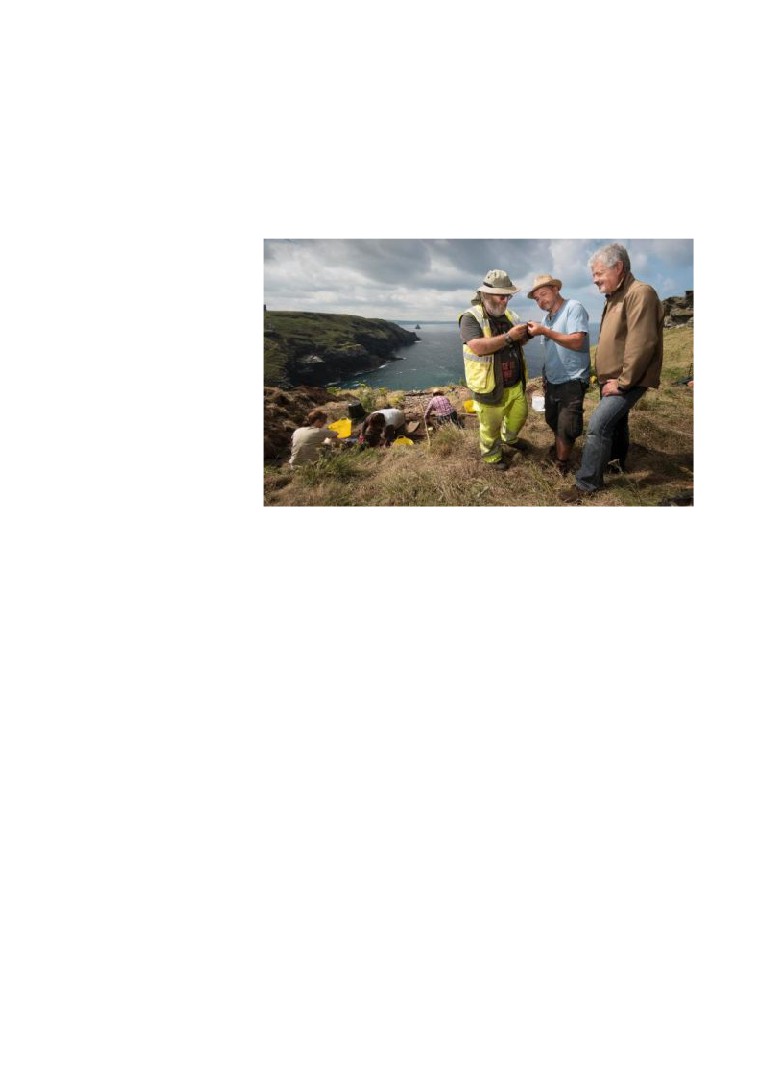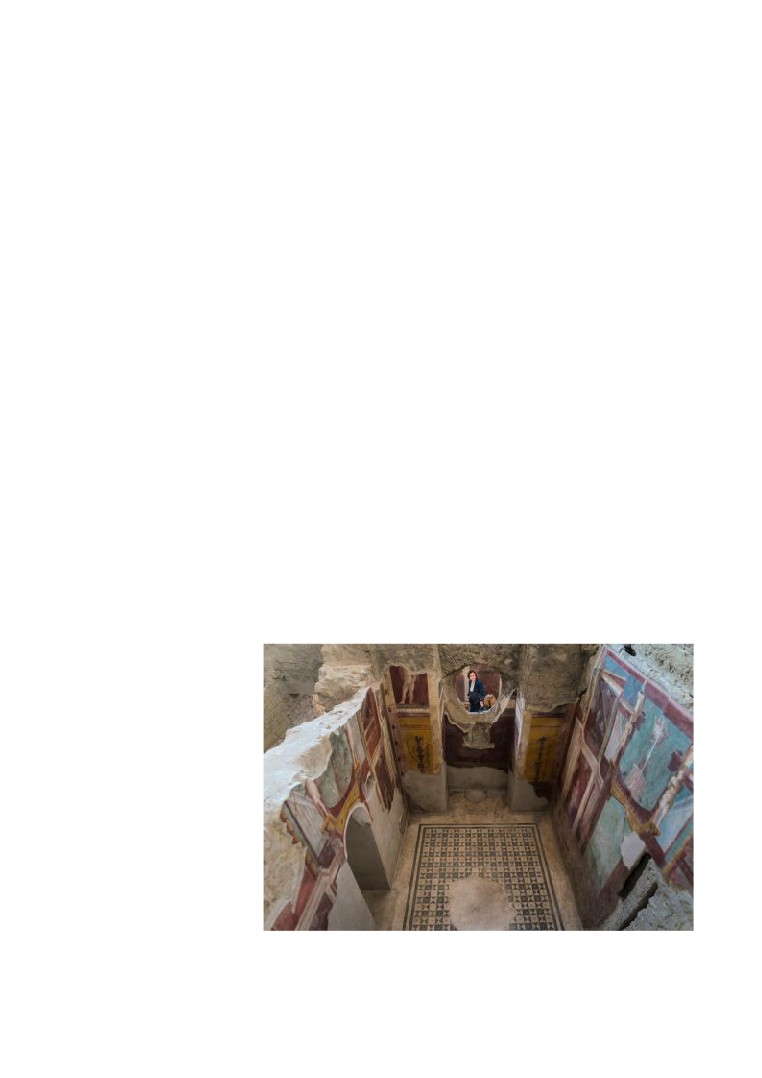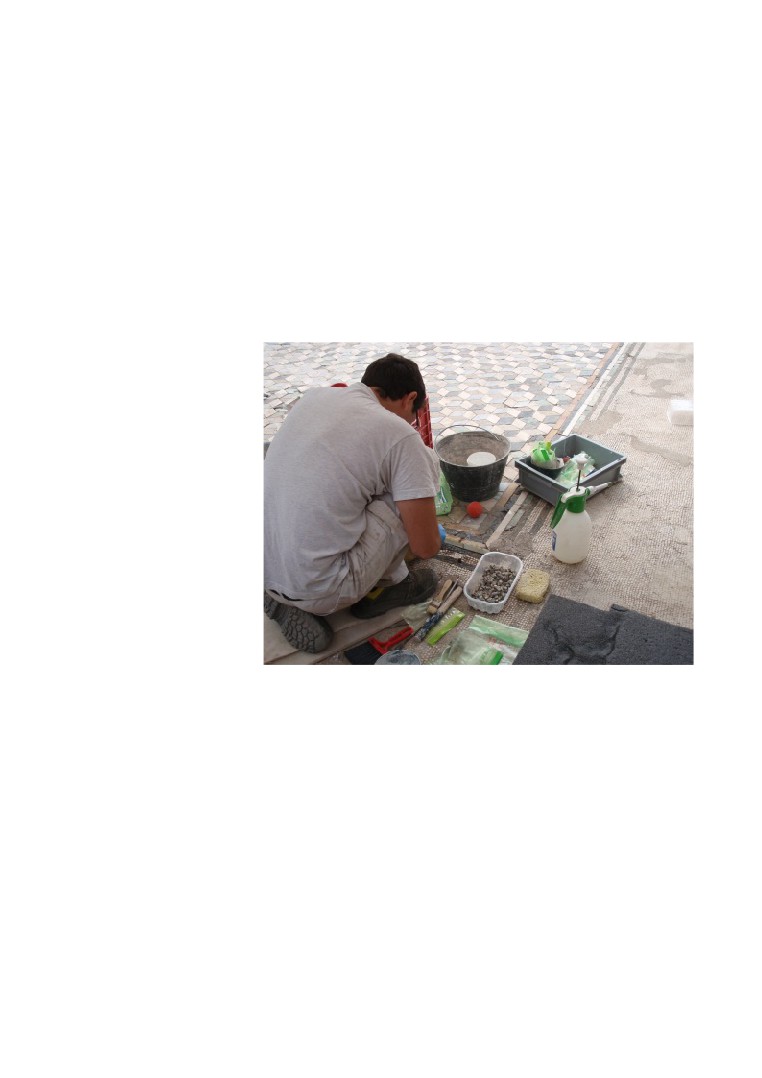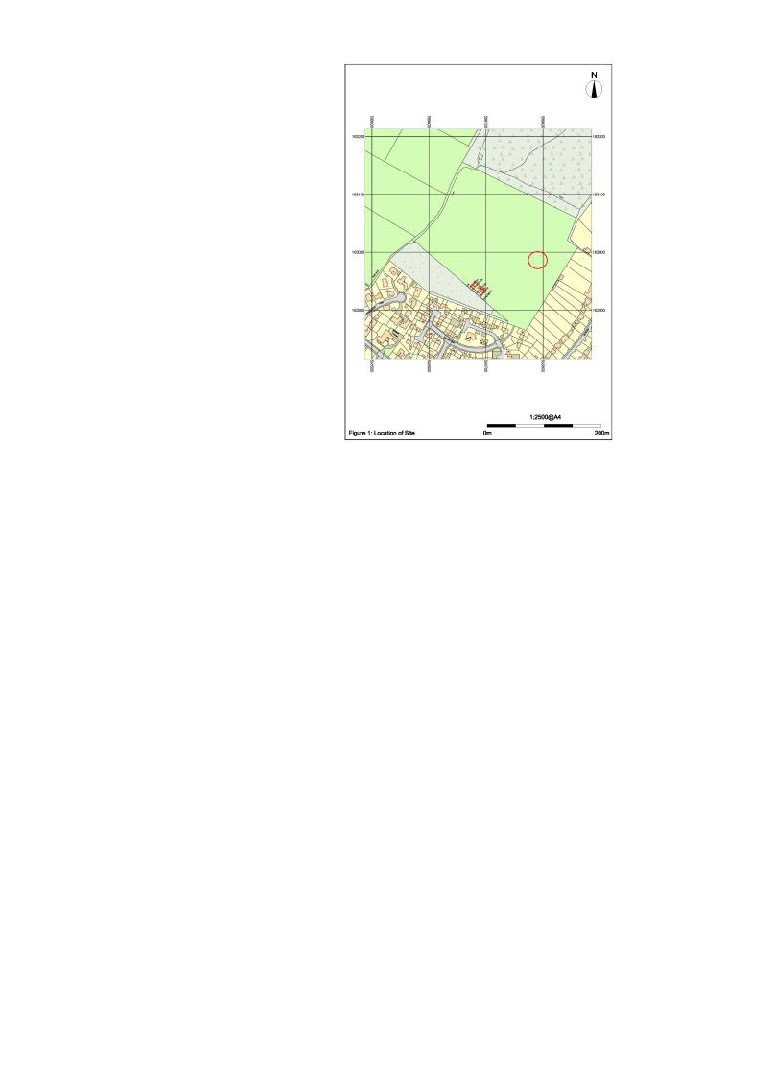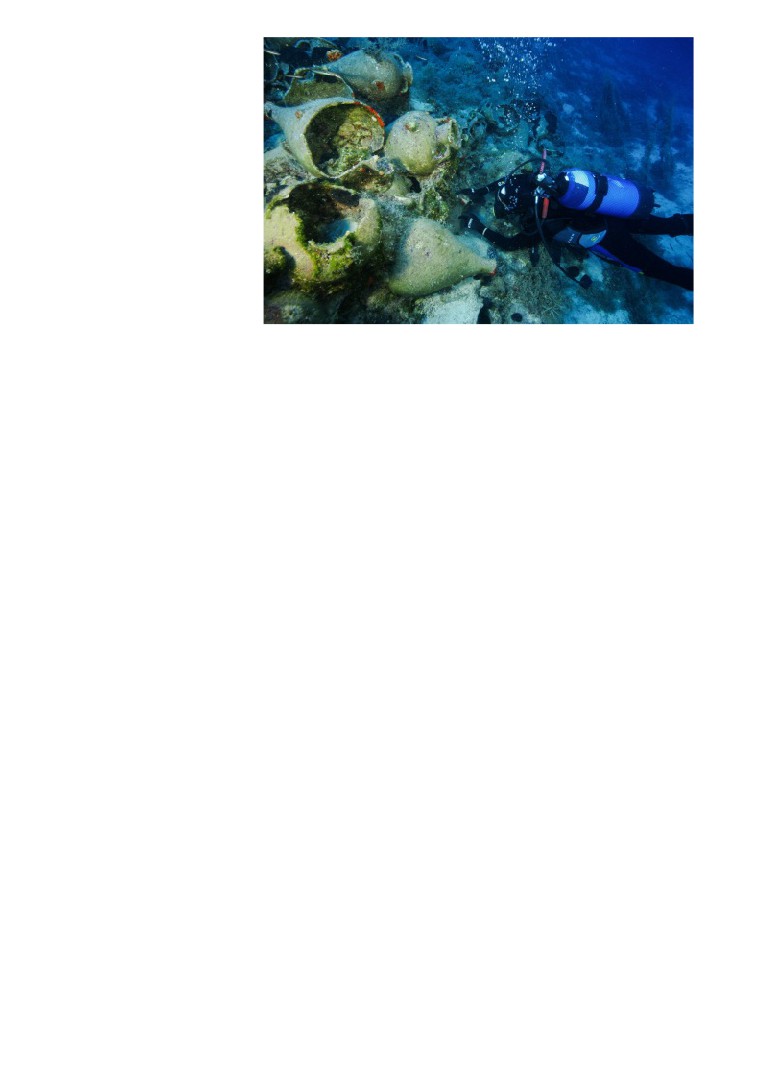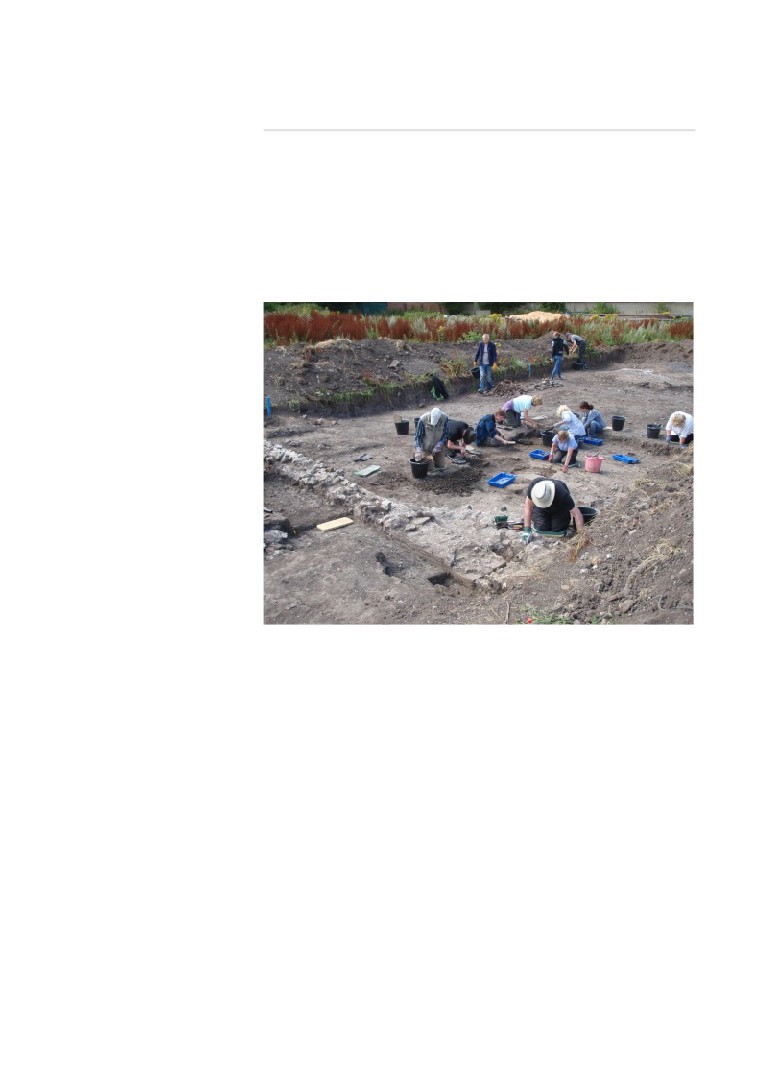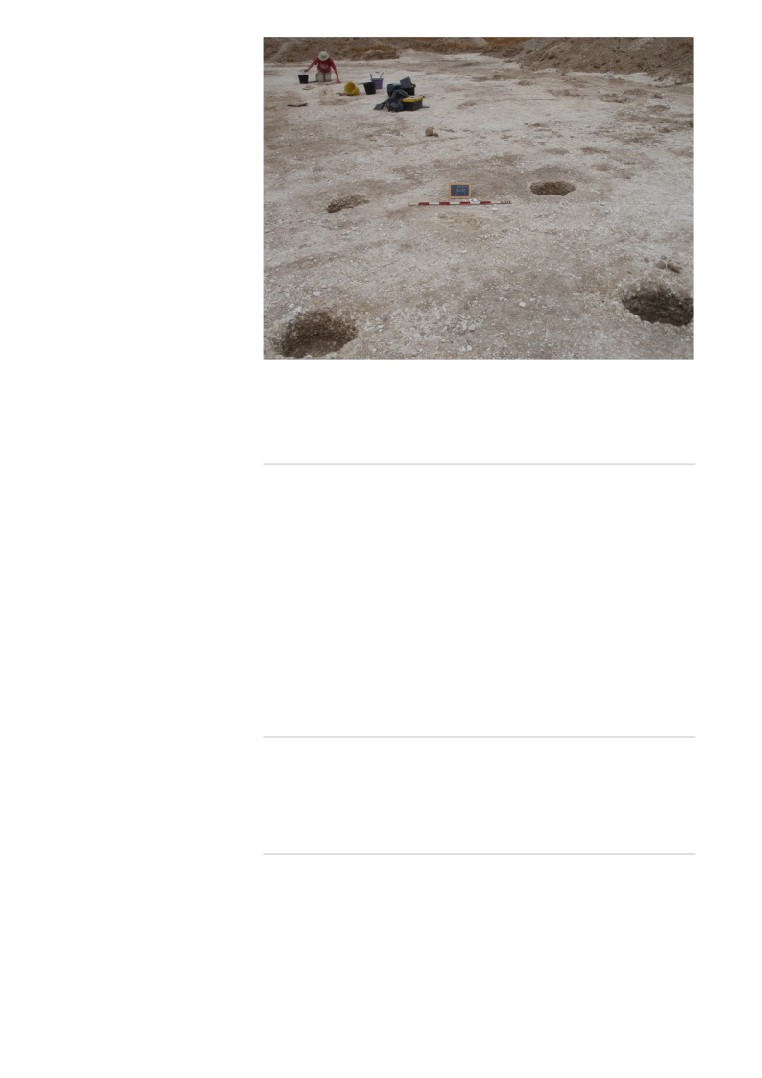Welcome to the Summer/Autumn 2016 Newsletter from
the Kent Archaeological Field School
WELCOME
BREAKING NEWS:
BREATHTAKING ARTIFACTS
FROM THE 3RD MILLENIUM
Dear Member, we will be sending a Newsletter
BC
email each quarter to keep you up to date with
BREAKING NEWS/2: ROMAN
news and views on what is planned at the Kent
PALATIAL VILLA FOUND
Archaeological Field School and what is
UNDER THE CHURCH AT
POSITANO IN ITALY
happening on the larger stage of archaeology
both in this country and abroad. For more
BREAKING NEWS/3: KING
ARTHUR'S PALACE FOUND
I do hope you enjoy this newsletter which looks
BREAKING NEWS/4: NEW
forward to a summer of exciting
‘digging’
AREAS OF POMPEII NOW
OPEN TO THE PUBLIC
opportunities. Paul Wilkinson.
RESEARCH NEWS: ROMAN
VILLA FOUND NEAR
SITTINGBOURNE, KENT UK
RESEARCH NEWS/2: SHIP
GRAVEYARD REVEALS
Letters: Stonehenge again
ANCIENT TREASURES
The National Trust and English Heritage have been criticised for backing a tunnel
BOOK REVIEW: PAX ROMANA
by Adrian Goldsworthy
under Stonehenge, which it is claimed could lead to the site losing its World
Heritage status. In a letter to The Times, Kate Fielden, the vicechairwoman of the
COURSES AT THE KENT
ARCHAEOLOGICAL FIELD
British Archaeological Trust, warned that the engineering works required to bury
SCHOOL FOR 2016 INCLUDE:
the A303 would irreparably damage "substantial tracts of an internationally
KAFS BOOKING FORM
renowned archaeological landscape — a World Heritage site that the government
is committed to protect under the 1972 World Heritage Convention". She added: "It
KAFS MEMBERSHIP FORM
is a matter of deep regret that the road scheme is supported by the National Trust...
and English Heritage."
Dr Fielden, a founding member of the Stonehenge Alliance, which opposes the
tunnel, said that it could lead to Stonehenge being "delisted" by Unesco, the UN
body that grants world heritage site status. The alliance prefers the option of a
bypass. Detailed planning has begun for the £2 billion, 1.8mile tunnel, which was
given the goahead by the government in 2014. In May the tunnel won the backing
of Unesco, which said the scheme must protect the "outstanding universal value" of
the site.
Breaking News:
Breathtaking artifacts from the 3rd millennium BC
Evidence of the esteem in which crystals were held can be found in a remarkable
set of crystal weapons found in the megalithic tombs of south western Spain. At the
site of Valencina de la Concepcon, archaeologists have uncovered crystal
arrowheads, an exquisite dagger blade, and cores used for creating the artifacts
that date to the 3rd millennium BC.
© Miriam Lucianez Trivino
The Montelirio tholos is a great megalithic construction...which extends over 43.75
m in total, constructed out of large slabs of slate. At least 25 individuals were
interred within the structure, along with "an extraordinary set of sumptuous grave
goods...the most notable of which is an unspecified number of shrouds or clothes
made of tens of thousands of perforated beads and decorated with amber beads".
Additionally however, a large number of crystal arrowheads were found together,
which be suggestive of a ritual offering at an altar. The arrowheads have the
characteristic long lateral appendices of flint arrowheads from the area
- but
investigators remarked that "even greater skill must have been required to produce
these unique features when using rock crystal."
Another large twochambered megalithic construction made from slate slabs. In the
second chamber archaeologists found the body of a young male aged between 17
and 25 lying in the foetal position along with a large set of grave goods. These
included an undecorated elephant tusk laid above the young man's head, a set of
23 flint blades, and numerous ivory objects. Additionally, red pigment made from
cinnabar had been sprayed over the body and the objects surrounding it. The
"remarkable crystal dagger blade", however, was not found with these grave
goods, but instead in the upper level of this chamber.
The rock crystal dagger blade appeared in the upper level of Structure 10.049 of
the PP4Montelirio sector, in association with an ivory hilt and sheath, which
renders it an exceptional object in Late Prehistoric Europe... The blade is 214 mm
in length, a maximum of 59 mm in width and 13 mm thick. Its morphology is not
unheard of in the Iberian Peninsula, although all the samples recorded thus far
were made from flint and not rock crystal...
The manufacture of the rock crystal dagger blade must have been based on an
accumulation of transmitted empirical knowledge and skill taken from the
production of flint dagger blades as well from knowhow of rockcrystal smaller
foliaceous bifacial objects, such as Ontiveros and Montelirio arrowheads... It was
obtained from a large monocrystal at least 220 mm in length and 60 mm in width.
Given that these single crystals are hexagonal, they would have a similar width
along all their different axes.
The rock crystal source used in creating the crystal weaponry has not been
pinpointed exactly at this stage, though analysis suggests two potential sources,
"both located several hundred km away from Valencina".
<<<<< BACK TO MENU >>>>>
Breaking News/2: Roman palatial villa found under the
church at Positano in Italy
Once we reach the spot, you won’t believe your eyes,” says archaeologist Luciana
Jacobelli of the University of Molise as she opens a small door to the crypt of the
church of Santa Maria Assunta in the centre of town. It’s very dim inside, and she
has to use a torch as we make our way. We slowly climb down a series of ladders
through a forest of iron scaffolding toward what seems to be the only welllit area,
nearly 30 feet under the church. Jacobelli then leads me into a room and, as
promised, frescoes in dazzling green, yellow, red, and blue seem to illuminate the
space on their own. We have arrived at the extraordinarily wellpreserved remains
of a lavish villa marittima, or seaside villa, once a luxurious retreat for the rich of
ancient Rome to escape the summer heat and the hustle and bustle of city life in
the first centuries B.C. and A.D.
Swiss architect and engineer Karl Weber, the first scholar to supervise excavations
of the areas destroyed by the eruption of Mount Vesuvius in A.D. 79, appears to
have seen the villa on April 16, 1758, during his explorations. In his field report he
writes that he had begun to dig near the “church with bell tower, not far from the
beach that is at the base of Mount Santa Maria a Castelli and Mount Sant’Angelo;
at a depth of 30 spans we found a famous ancient building whose first mosaic is
made of white and fine marble.” It was only during restoration work on the crypt in
2003 that archaeologists had a chance to enter the villa’s stunning triclinium, or
dining room, for the first time. But after only three years of digging, they were forced
to stop when funding ran out, and it wasn’t until the summer of 2015 that
excavations resumed. For the rest of the year, before funding for the project ran out
again, Jacobelli led a rescue excavation under the supervision of the local
archaeological superintendent, Adele Campanelli, and archaeological supervisor
Maria Antonietta Iannelli. A team of archaeologists and conservators worked to
remove mud and lapilli (small stones ejected by a volcanic eruption) and to expose
and clean the stunning wall paintings emerging from the debris (Archaeology
August issue 2016)
<<<<< BACK TO MENU >>>>>
Breaking News/3: King Arthur’s palace found
A royal palace has been discovered in the area reputed to be the birthplace of
King Arthur.
The palace discovered at Tintagel in Cornwall is believed to date from the sixth
century around the time that the legendary king may have lived. They believe the
onemetre thick walls being unearthed are from a 6th century palace belonging to
the rulers of the ancient southwest British kingdom of Dumnonia.
Excavations have been taking place at the site as part of a fiveyear research
project being run by English Heritage at the
13th century Tintagel Castle in
Cornwall to find out more about the historic site from the fifth to the seventh
centuries.
Using cutting edge techniques, Cornwall Archaeological Unit
(CAU), part of
Cornwall Council, uncovered the walls of the palace and more than 150 fragments
of pottery and glass which had been imported to the site from exotic locations
across the globe indicating it was inhabited by wealthy individuals. Finds include
sherds of imported lateRoman amphorae, fragments of fine glass, and the rim of a
Phocaean redslip ware which is the first piece of fine tableware found on the site
Made in western Turkey and dating from the 5th or 6th century , experts say it is the
fragment of a bowl or a large dish which may have been used for sharing food
during feasting.
Win Scutt, English Heritage’s properties curator for the West, said: “This is the most
significant archaeological project at Tintagel since the 1990s.“The threeweek dig
is the first step in a five year research programme to answer some key questions
about Tintagel and Cornwall’s past. “The discovery of highstatus buildings -
potentially a royal palace complex - at Tintagel is transforming our understanding
of the site. "We’re cutting a small window into the site’s history, to guide wider
excavations next year. We’ll also be gathering samples for analysis. It’s when
these samples are studied in the laboratory that the fun really starts, and we’ll
begin to unearth Tintagel’s secrets.”
The team dug four trenches in two previously unexcavated terrace areas of the
island settlement and discovered buildings believed to date from the fifth centuries,
when RomanoBritish rulers fought for control of the island against the Anglo
Saxon invaders. Geophysical surveys of the terraces earlier in the year detected
the walls and layers of the buried buildings, and the archaeologists have
discovered two rooms around 11 metres long and 4 metres wide.
Tintagel is one of Europe’s most important archaeological sites. The remains of the
castle, built in the 1230s and 1240s by Richard, Earl of Cornwall, brother of Henry
III, stand on the site of an early Medieval settlement, where experts believe high
status leaders may have lived and traded with faroff shores, importing exotic
goods and trading tin.
Previous excavations have uncovered thousands of pieces of pottery at Tintagel -
with the vast majority dating from the fifth to seventh centuries and imported from
the Mediterranean.
The excavation team, directed by Jacky Nowakowski, principal archaeologist at
CAU, is working with specialists from Historic England and geophysicists from
TigerGeo Ltd. She said: “CAU are very excited to be involved in English Heritage’s
research project at Tintagel. This new archaeological research project will
investigate unexplored areas of the island in order to find out more about the
character of the buildings on this significant postRoman settlement at Tintagel. "It
is a great opportunity to shed new light on a familiar yet infinitely complex site
where there is still much to learn and to contribute to active research of a major site
of international significance in Cornwall. Our excavations are underway now, and
will run both this summer and next, giving visitors the chance to see and hear at
first hand new discoveries being made and share in the excitement of the
excavations.”
The earliest accounts about King Arthur have come from the writings of the sixth
century monk Gildas. A much fuller account of Arthur's life was written many
centuries later by Geoffrey of Monmouth, which may have drawn on earlier sources
but was suspected of being wildly embellished (Daily Telegraph August 2016).
<<<<< BACK TO MENU >>>>>
Breaking News/4:
New areas of Pompeii now open to the public
Tourists in ancient Pompeii have freshly restored marvels to admire, including a
merchant’s luxuriously decorated home and a more modest middleclass dwelling.
A business where Pompeii residents brought fabrics to be cared for and a structure
with thermal bathing areas are also among the six buildings opened to the public
this year after a €105m (£77m) restoration.
found little had been done. Pompeii in recent years has been plagued by union
disputes, which left tourists locked out, and the collapse of some ruins, with a
chronic shortage of funds for maintenance.
But the Italian Prime Minister, Matteo Renzi, expressed optimism at the unveiling of
restored ruins in the city destroyed in AD79 by a volcanic eruption. He said: “We
made news with the collapses, now we are making news with restoration.”
One of the most eagerly anticipated restorations (now open) is of the Fullonica di
Stephanus, a specially designed laundry equipped with large baths for rinsing dirty
tunics and basins for dyeing fabrics. There was a press for ironing and a place to
store urine, which was collected in public toilets and used to get out tough stains.
Clothes would be trampled by workers in tubs at the back of the premises.
(Credit: Paul Wilkinson)
Paul Wilkinson’s Archaeological Guide to Pompeii is to be published in the spring
of 2017: An excerpt from the description of the Marine Baths is published below:
“The main entrance (1) is located to the north of the porticoed road leading uphill to
the Marine Gate. Comprising a gated vestibule with a façade framed by two half
columns, walk through and you are in a porticoed (2) triangular area paved with
creamy white slabs of tufa stone. The entrance to the baths is on the right through
the changing room (3), frescoed in the 4th style with eight numbered erotic scenes
on the upper part of one wall.
We have entered a world of unbridled sexuality where various positions and
pleasures are numbered, presumably so the male clientele could, if they wished,
after their bath, retire upstairs to the three flats and enjoy from prostitutes ‘number 5
or number 7’. The staircase to this sexual heaven is located internally, in the south
corner of the complex (4).
The scenes are half of the original number to have survived and, frescoed just
beneath the erotic scenes, are painted numbered cupboards, probably just like the
remains of red cupboards that were found below by archaeologists.
From the changing room (apodyterium) we enter the cold room (5), with its cold
plunge pool on the right (6). The changing room is floored with marble slabs, 4th
style stucco, and the pilaster columns supported a corbel and a barrelvaulted roof,
whose ceiling is panelled with stucco reliefs, which include cherubs riding tritons,
with others showing chariots drawn by billygoats. The chariots are filled with
various objects, including cornucopias, thyrsus and theatrical masks.
The wall panels are framed by fluted pillars capped by an ovolo, arched cornice
with egg and dart decoration. The subject matter of the panels ranges from
cherubs to flying storks.
Leading off from the cold room (frigidarium) is the cold plunge pool (6), with its
walls frescoed with seascapes and Nilotic scenes. The pool (balneum) was filled
by a cascade of water from a highly decorated nymphaeum, framed in a mosaic
covered alcove arch, with two columns holding up a mosaiccovered architrave
topped by triangular pediments.
The central wall mosaic in the niche portrays Mars and two cherubs holding his
weapons.
The next room is the warm room (7) with its hypocaust heating of the floor and
walls and in the corner of the room is a door to the sauna (8), with its four apses set
into its wall. The circular laconicum was used for dry sweat baths. The circular
shape is a standard design for this type of room - a small circular space, where
high heat could be produced (Vitruvius 5.10.5). The room is roofed with a masonry
cone that springs just above the crown of the four apses set into its walls.
The baths are devoid of statues and furniture and it seems the bath house was
badly damaged in the earthquake of 62 AD and was still undergoing repair at the
time of the eruption of Vesuvius in 79 AD. After the eruption it seems salvage work
by the Romans took place, which continued throughout the Middle Ages to modern
times. Archaeologists have found both medieval and 18th century pottery sherds in
secure contexts and, although known about in the
19th century, it was not
completely excavated till the excavation campaign of 19871992.
Even in its sorry state, the magnificence of the decoration, the beauty of the rooms
and the sheer thrill of stepping back into an almost complete, state of the art 1st
century BC Roman bathhouse is an experience not forgotten.
Leaving the bathhouse, turn left and ascend the original Roman road, with its
basalt rock surface, to the Marine Gate. On your right you will see the imposing
remains of ‘The Imperial Villa’, built at the end of the 1st century BC against the city
walls. A portico, supported by 41 fluted stucco columns, supported the roof and
protected the rear wall of the portico, which was decorated in the 3rd style with a
black fresco background, framed by slender aedicules and embellished by
figurative medallions and small ‘emblem’ painting, most of which were removed by
the 18th excavators. Midway along the portico, and its architectural focus, is an
imposing structure, interpreted as a dining or entertainment room. The fresco
decoration is in the 4th style and shows scenes from mythology, including Theseus
slaying the Minotaur, Daedalus flying and Icarus, having fallen from the air, dead
on the ground.
We enter Pompeii by one of the original gates, now called ‘The Marine Gate’. The
road to the gate is too steep for carts and it is likely that goods and cargo from the
nearby harbour would have been carried by mule or porter. The gate originally had
two arches, one for pedestrians only and was subsequently rebuilt as one
entrance, with a barrelvaulted roof in opus caementicium (mix of mortar and
stone). Both entrances were closed with sets of double doors, as can be seen by
marks left by the doors on the basalt road surface”.
The book will have over 50 numbered plans drawn from site survey just for this
book. An example, the Marine Baths is below.
<<<<< BACK TO MENU >>>>>
Research News: Roman villa found near Sittingbourne, Kent UK.
Paul Wilkinson reports on a research project by the Kent Archaeological Field
School. Field walking two years ago identified the remains of a Roman building at
Borden just to the south of Sittingbourne. An initial geophysical survey was
inconclusive but a follow up archaeological evaluation exposed the remains of
Roman foundation walls (plan below and photo).
The building is on the fringe of the field and because of deep ploughing most of the
structure has been ploughed away and just survives below the plough zone. As a
Roman villa the building should face southeast and it is possible that we have
exposed the southern ‘wing’ of the villa with the rest of the ‘winged’ villa awaiting
discovery to the northeast. Incidentally in an area that field walking has retrieved
hundreds of sherds of Samian ware which now await dating. Artefacts retrieved by
excavation and field walking include multi coloured painted plaster, hundreds of
terracotta tessellated floor tiles, box flue tiles which show the building had central
heating and literally tons of ceramic roof tiles, both tegula and imbrix. This is just
another Roman villa along the north Kent strip of Watling Street and now takes the
number of known Roman villas to 22 and we are sure there are others awaiting
discovery.
Excavating one of the walls of the Borden Roman villa (credit Paul Wilkinson)
<<<<< BACK TO MENU >>>>>
Research News/2: Ship Graveyard reveals ancient
treasures
Over a stretch of two weeks in September, tips from local fishermen and sponge
divers led a team of Greek and American archaeologists to the precise locations of
22 shipwrecks in a 17squaremile area around the Fourni archipelago in the
eastern Aegean.
The find is remarkable both for the sheer number of wrecks in the small area and
the range of time periods the vessels came from.
The earliest wreck dates to the Archaic Period (700480 B.C.), while the most
recent is from the Late Medieval Period
(16th century A.D.). Ships from the
Classical Period (480323 B.C.) and the Hellenistic Period (32331 B.C.) were also
found, though a majority—12 of the 22—sailed and sank at some point during the
Late Roman Period (300600 A.D.)
“It’s an extremely rich area,” says Greek director George Koutsouflakis, an
archaeologist with the Hellenic Ephorate of Underwater Antiquities.
Finding 22 shipwrecks in only two weeks is incredibly rare, but more discoveries in
the area are likely—the team has surveyed only 5 percent of Fourni’s coasts, and
local fishermen have given them many more tips.
All the ships were merchant vessels traversing a route that connected Anatolia,
Samos, and the Black Sea region to Rhodes, Cyprus, and even Egypt. Wooden
ships generally decompose underwater or get eaten by sea worms. But their cargo
—ancient clay storage jars called amphorae—survive. Each ship was carrying
several hundred amphorae. By assessing the size and shape of the jars,
archaeologists can infer where and when they were made.
Residue or DNA analysis will confirm what they contained, but the primary goods
are not in doubt.
“We know from comparable shipwrecks and terrestrial sites that the three major
goods would have been olive oil, wine, and fish sauce,” says Jeffrey Royal, a co
director from the Floridabased RPM Nautical Foundation.
The archaeologists have only begun to analyse the material they collected from
the shipwrecks in September, but the abundance of late Roman ships is already
striking. They suspect that this apparent spike in traffic may be linked to the rise of
Constantinople and the Eastern Roman Empire in the fourth century. They expect
their ongoing research to answer many specific questions about ancient maritime
trade networks and how they related to the shifting political structures of the
Eastern Mediterranean.
Fourni was already known to some smugglers before this September’s survey.
Locals had reported seeing suspicious activity in the water near certain sites, and
the archaeologists found some evidence of looting when they dove the wrecks.
Pinpointing exact locations for 22 of the area’s shipwrecks will make it easier for
Greek authorities to supervise the sites. The archaeologists also hope that the
knowledge gained during excavations will give local communities a stronger
sense of connection to their history.
<<<<< BACK TO MENU >>>>>
Book Review: Pax Romana by Adrian Goldsworthy
"The Pax Romana provided a remarkable period of peace and stability, rarely seen
before or since. Yet the Romans were first and foremost conquerors, imperialists
who took by force a vast empire stretching from the Euphrates in the east to the
Atlantic coast in the west. Their peace meant Roman victory and was brought
about by strength and dominance rather than coexistence with neighbours. The
Romans were aggressive and ruthless, and during the creation of their empire
millions died or were enslaved.
But the Pax Romana was real, not merely the boast of emperors, and some of the
regions in the Empire have never again lived for so many generations free from
major wars. So what exactly was the Pax Romana and what did it mean for the
people who found themselves brought under Roman rule?
Acclaimed historian Adrian Goldsworthy tells the story of the creation of the
Empire, revealing how and why the Romans came to control so much of the world
and asking whether the favourable image of the Roman peace is a true one. He
chronicles the many rebellions by the conquered, and describes why these broke
out and why most failed. At the same time, he explains that hostility was only one
reaction to the arrival of Rome, and from the start there was alliance, collaboration
and even enthusiasm for joining the invaders, all of which increased as resistance
movements faded away.
A groundbreaking and comprehensive history of the Roman Peace, Pax Romana
takes the reader on a journey from the bloody conquests of an aggressive
Republic through the age of Caesar and Augustus to the golden age of peace and
prosperity under diligent emperors like Marcus Aurelius, offering a balanced and
nuanced reappraisal of life in the Roman Empire."
A couple of questions and answers from the Yale University Press catalogue:
Why this book?
Peace is always a rare and precious thing and this makes the “Roman Peace” all
the more remarkable, and I wanted to understand how it came about. I wanted also
to understand what the Roman Empire meant to the people who lived in it. What
was it like for the other peoples in the ancient world who found themselves living
next to the Roman Empire, or were incorporated into it, whether by force or choice?
It is simplistic to demonize empires—just as it once was to celebrate them
uncritically—and there is a danger of turning conquered peoples into passive and
virtuous victims of imperialist aggression. The truth is more complicated, and
looking at Roman power from the viewpoint of Romans and outsiders provides
many relevant insights to our own world.
But wasn’t "Pax Romana" the peace imposed by the victors, whose conceit
was that they were bringing civilization to barbarians?
The Romans fought a lot of wars, and never granted other peoples equal status.
Other kingdoms and states were either allies or real or potential enemies. Peace
made Rome and its allies safe. Only once they were well on their way to
establishing a large and permanent empire did the Romans begin to talk of a duty
to bring peace, order, and the rule of law to a wider world. This was not achieved
solely or even primarily by force. People wanted to be Roman. Peace became a
reality, even if imperfect.
<<<<< BACK TO MENU >>>>>
Courses at the Kent Archaeological Field School for 2016
include:
May 30th to June 17th 2016 excavating at 'Villa B' at Oplontis
next to Pompeii in Italy
A brilliant three weeks with over 25 students each week excavating a number of
important area of the Roman Palace. For more information access the story so far
with the report on the Preliminary Notes on Two Seasons of Research at Oplontis
B during 2014 and 2015. Printed in the Journal of Fasti Online (ISSN 18283179),
and published by the Associazione Internazionale di Archeologia Classica. Please
use the link below to download the full report.
August 6th to 14th 2016. The Investigation of a substantial Roman Building at
Abbey Barns in Faversham
Ongoing excavations at a previously unrecorded Roman building in Kent have
uncovered evidence of an emporium serving the port at Faversham - then called
Durolevum.
Discovered in 2012 by the Kent Archaeological Field School (see CA 261), recent
work has shown that the waters of the Swale estuary lapped the buildings, which
during the Roman period sat beside a large tidal inlet deep enough to harbour
ships.
Current work on the complex’s bathhouse has yielded prestigious small finds
including silver jewellery, exotic glass vessels and large quantities of coloured wall
plaster which, together with the structure’s impressive dimensions, measuring
some 45m by 15m, suggests a building of some importance.
A silver finger ring found in the demolition rubble has been dated to the Anglo
Saxon period and similar rings found at Dover have a date of c. 575625 AD. The
ring, only big enough for a child’s hand suggests the building was demolished in
the late 6th century to make a platform for a timber hall found in last year’s
excavation. Pottery in the cill beam slots dated this building also to the 6th century.
KAFS director Dr Paul Wilkinson says the latest findings suggest it had rather
humbler origins, however.
‘The building was originally built in the 2nd century AD as an aisled barn with a
concrete and chalk floor,’ he said. ‘We have found the remains of stalls used to
house farm animals in the Roman estate. But very soon afterwards the building
was rebuilt as a huge bathhouse, with plunge pools, hot rooms, steam rooms, and
warm rooms for massage.’
‘The decoration has the feel of a municipal baths with none of the luxurious
features one would expect of a private enterprise bathhouse,’ he added. ‘Given the
size of the bathhouse it is far too large for a Roman villa estate and must have
catered for another set of clientele. It is probably too far from the main Roman road
to London (Watling Street) to have been an Imperial posting house with hotel but it
probably sits astride the Roman port of Faversham and may have catered for the
crews of visiting ships.’
Pottery from the site has been dated by Malcolm Lyne which indicates the building
continued in use to the late 4th century and into the early Saxon period being
demolished in the 12th century. ‘Latest investigations in 2016 have unravelled
some of the mystery of the building’s function including the uncovering the bases
of three of the stone columns of the aisled building. This is the second very large
stone aisled building to be excavated by the field school and in both instances the
‘posts’ were not timber but constructed out of stone blocks with on this occasion an
op sig floor. We will return for more investigation in 2017.
September
3rd to
11th
2016. Investigation of Prehistoric features at
Hollingbourne in Kent
Villagers in Harrietsham pride themselves on living in a historic Kentish village, but
do they know quite how old it might be? An archaeological dig in a field near Court
Lodge Farm has uncovered evidence of a prehistoric settlement. A dozen
volunteers directed by Dr Paul Wilkinson, of the Kent Archaeological Field School,
conducted an investigation after some aerial shots revealed what looked like a site
of interest. The team unearthed signs of a drovers' road leading down from the top
of The Downs to a spring, bordered by two ditches [dated to the Bronze Age by
pottery sherds], and also postholes and ditches from an enclosure. Dr Wilkinson
said: "It's a very exciting site because it has been in multioccupation. "There is
evidence of Bronze Age, Iron Age and early Roman settlement. "There were two
enclosures: one from the Iron Age, and inside it what seems an early Roman fortlet
with a watchtower. 'There is evidence of Bronze Age, Iron Age and early Roman
settlement' "The tower would have given the Roman army a fantastic view over the
countryside and control of who accessed the springs." Some fragments of pottery
were recovered from one of the ditches and are currently undergoing analysis. Dr
Wilkinson said: "It's what we call a black and white site: under a thin layer of top
spoil there's chalk, which makes it very easy to see where the archaeology is as it
shows up black." After 10 days, the dig has been closed for this season and the
findings covered over, but Dr Wilkinson said he would return with another KAFS
team next year. "It's a work in progress," he said. Once the report on this year's dig
has been written, the findings will be published on the field school's website.
January 2017
The Kent Archaeological Field School, School Farm Oast,
Graveney Road, Faversham, Kent ME13 8UP
Director Dr Paul Wilkinson
KAFS BOOKING FORM
You can download the KAFS booking form for all of our forthcoming courses
KAFS MEMBERSHIP FORM
You can download the KAFS membership form directly from our website, or by
<<<<< BACK TO MENU >>>>>
If you would like to be removed from the KAFS mailing list please do so by clicking here
